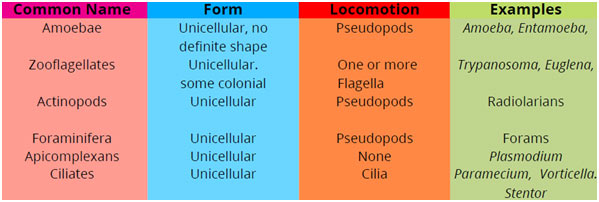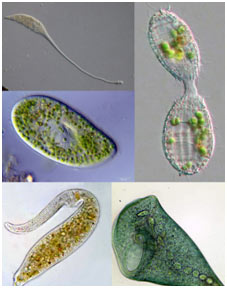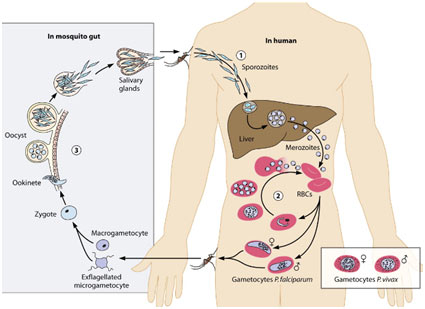Kingdom Protista
The Kingdom Protista includes a large variety of mostly aquatic eukaryotic organisms whose diverse body forms, forms of reproduction, modes of nutrition, and lifestyles make them difficult to identify.
This kingdom is defined by exemption i.e., all members have characteristics that omit them from the other four kingdoms. All protists are eukaryotic and have actually developed from prokaryotes.
Another reason for producing a different kingdom arises from the difficulty in placing particular eukaryotic organisms in a suitable kingdom.
This difficulty is a consequence of the reality that the other eukaryotic kingdoms have their evolutionary origin in kingdom Protista. The other eukaryotic kingdoms Plantae, Fungi, and Animalia arose from protists in numerous ways.
The protists are unicellular, colonial, or simple multi cellular organisms that have a eukaryotic cell organization.
Eukaryotic cells, the unifying feature of protists, are common to complex multicellular organisms belonging to the three eukaryotic kingdoms (Fungi, Plantae, and Animalia) however clearly differentiate protists from members of the prokaryotic kingdom (Monera).
Unlike plants and animals, however, protists do not develop from a blastula or an embryo.
The kingdom Protista consists of four major groups of eukaryotic organisms which are: single-celled protozoans, unicellular algae, multicellular algae, slime molds, and oomycotes.
Historical Perspective of Kingdom Protista
In 1861, John Hogg proposed the kingdom Protoctista for microscopic organisms. In 1866, Ernst Haeckel suggested developing the Kingdom Protista to include bacteria and other microbes (such as Euglena) in that kingdom. He, however, separated blue-green algae and bacteria (prokaryotes) from nucleated protists and positioned them in a different group he called Monera, within the kingdom Protista.
In 1938, Herbert Copeland raised the prokaryotes to kingdom status, hence separating them from Protista. In the five-kingdom system of Robert Whittaker (1969) just unicellular eukaryotes were positioned in kingdom Protista. Currently, this kingdom also includes colonial and simple multicellular eukaryotes too. Margulis and Schwartz (1988) modified the five-kingdom system. Protista or Protoctista is one of the five kingdoms.
Diversity among Kingdom Protista
During the course of evolutionary history, organisms in the kingdom Protista have progressed diversity in their (a) size and structure, (b) means of locomotion, (c) ways of getting nutrients, (d) interactions with other organisms, (e) habitat and (f) modes of reproduction. Variety is shown by all of the significant protist groups.
Based upon the diversity, the majority of biologists concern the protists kingdom as a polyphyletic group of organisms; that is, the protists probably do not share a single typical ancestor. Margulis and Schwartz have actually noted 27 phyla to accommodate this diverse assemblage of organisms.
Protozoa: Animal-like Protists
All protozoans are unicellular. Many ingest their food by endocytosis. These are some major groups.

(a) Amoebae
This group includes all free-living freshwater, marine, and soil amoebae in addition to those that are parasites of animals. Amoebae lack flagella and move by forming specialized cytoplasmic projections called pseudopodia (false feet). Amoeba constantly alters shape as the organism moves and feeds.
The digestive tract parasite, Entamoeba histolytica, triggers; amoebic dysentery in people.
The Giant Amoeba
The giant amoeba Pelomyxa palustris may be the most primitive of all eukaryote like kinds. This species has several membrane-bound nuclei but none of the other organelles found in all other eukaryotes. The giant amoebas obtain energy from methanogenic bacteria, which reside inside them. Giant amoebas inhabit mud at the bottom of freshwater ponds, where they contribute to the degradation of natural molecules.

(b) Zooflagellates
These protists are primarily unicellular (a few are colonial) organisms with round or elongated bodies with a single center nucleus. They have from one to many long, whip-like flagella that enable them to move. Flagellates move rapidly, pulling themselves forward by lashing flexible flagella, which are generally found at the anterior end.
Flagellates get their food either by ingesting living or dead organisms or by taking in nutrients from dead or decomposing raw material. They may be free-living, symbionts, or parasites. Tritonymphs are complex, specialized flagellates with many flagella that live as symbionts in the guts of termites and help in the food digestion of dry wood.
Parasitic flagellates trigger illness. For instance, Trypanosoma is a human parasite causing African sleeping sickness. It is transferred by the bite of the infected tsetse fly.
Choanoflagellates are sessile marine or freshwater flagellates that are attached by a stalk and their single flagellum is surrounded by a fragile collar. They are of special interest because of their striking resemblance to collar cells in sponges.

(c) Ciliates
Ciliates are unicellular organisms with a flexible external covering called a pellicle that provides a definite however changeable shape. In Paramecium, the surface area of the cell is covered with a number of thousand fine, short, hair-like structures called cilia.
The cilia beat in such an exactly collaborated style that the organism can move forward, can also go back and turn around. Some ciliates are sessile and stay connected to a rock or other surface area. Their cilia set up water currents that draw food towards them. Many ciliates consume bacteria or other small protists.
Water regulation in freshwater ciliates is controlled by unique organelles called contractile vacuoles. Ciliates differ from other protozoans in having 2 types of nuclei. Several little diploid micronuclei operate in the sexual process and a large, polyploid macronucleus manages cell metabolic process and growth. Many ciliates are capable of a sexual procedure called conjugation. Throughout conjugation 2 individuals come together and exchange hereditary material.

(d) Foraminifera’s and Actinopods
These marine protozoans produce shells (or tests). Tests of foraminifera are made from calcium whereas those of actinopods are made of silica. The shells or tests include pores through which cytoplasmic projections can be extended.
These cytoplasmic projections form a sticky, interconnected web that entangles prey. Dead foraminifera sinks to the bottom of the ocean where their shells form a grey mud that is slowly changed into chalk. Foraminifera of the past has created huge limestone deposits.

(e) Apicomplexans
Apicomplexans are a large group of parasitic protozoa, some of which trigger major diseases such as malaria in human beings. Apicomplexans do not have specific structures for locomotion however move by flexing. At some phase in their lives, they establish a spore, a small infective agent sent to the next host. Lots of Apicomplexans spend part of their life in one host and part in a different host species.
Plasmodium, the apicomplexan that triggers malaria, gets in human blood through the bite of a contaminated female Anopheles mosquito. Plasmodium first gets in liver cells and after that red blood cells, where it multiplies. When each infected red cell bursts, many new parasites are released.
The released parasites contaminate new red cells, and the procedure is repeated. The synchronized bursting of countless red cells triggers the symptoms of malaria; a chill, followed by high fever brought on by harmful substances that are released and affect other organs of the body.

Multiple Choice Questions (MCQs) with Answers:
- What is the defining characteristic of organisms in the kingdom Protista?
- a) Prokaryotic cell organization
- b) Unicellular structure
- c) Eukaryotic cell organization
- d) Development from blastula
Answer: c) Eukaryotic cell organization
- Who proposed the kingdom Protoctista for microscopic organisms in 1861?
- a) Ernst Haeckel
- b) Herbert Copeland
- c) John Hogg
- d) Robert Whittaker
Answer: c) John Hogg
- In the five-kingdom system of Robert Whittaker, which organisms were initially placed in kingdom Protista?
- a) Unicellular eukaryotes
- b) Multicellular plants
- c) Prokaryotes
- d) Fungi
Answer: a) Unicellular eukaryotes
- According to Margulis and Schwartz (1988), how many phyla were noted to accommodate the diverse protist assemblage?
- a) 10
- b) 15
- c) 20
- d) 27
Answer: d) 27
- What is a unifying feature of protists?
- a) Blastula development
- b) Prokaryotic cell organization
- c) Eukaryotic cells
- d) Colonial structure
Answer: c) Eukaryotic cells
- Which major group of organisms is included in the kingdom Protista?
- a) Plants and Animals
- b) Fungi and Animals
- c) Protozoans, Algae, Slime Molds, and Oomycotes
- d) Bacteria and Algae
Answer: c) Protozoans, Algae, Slime Molds, and Oomycotes
- What is the primary means of locomotion for amoebae?
- a) Flagella
- b) Cilia
- c) Pseudopodia
- d) Contractile vacuoles
Answer: c) Pseudopodia
- Which protozoan causes amoebic dysentery in humans?
- a) Trypanosoma
- b) Entamoeba histolytica
- c) Plasmodium
- d) Tritonymphs
Answer: b) Entamoeba histolytica
- What is the function of the contractile vacuole in freshwater ciliates?
- a) Reproduction
- b) Food digestion
- c) Water regulation
- d) Locomotion
Answer: c) Water regulation
- Foraminifera and Actinopods are known for producing:
- a) Shells made of silica
- b) Shells made of calcium
- c) Flagella for locomotion
- d) Pseudopodia for movement
Answer: b) Shells made of calcium
- Which group of protozoa is responsible for causing malaria in humans?
- a) Amoebae
- b) Ciliates
- c) Zooflagellates
- d) Apicomplexans
Answer: d) Apicomplexans
- How do Apicomplexans move?
- a) Flagella
- b) Pseudopodia
- c) Contractile vacuoles
- d) Bending
Answer: d) Bending
- What is the primary mode of reproduction in many ciliates?
- a) Conjugation
- b) Binary fission
- c) Spore formation
- d) Budding
Answer: a) Conjugation
- How do Zooflagellates move?
- a) Pseudopodia
- b) Contractile vacuoles
- c) Flagella
- d) Cilia
Answer: c) Flagella
- Which protozoan group contributes to the degradation of natural molecules in freshwater ponds?
- a) Zooflagellates
- b) Ciliates
- c) Foraminifera
- d) Amoebae
Answer: d) Amoebae
Frequently Asked Questions (FAQs) about Kingdom Protista:
- What is Kingdom Protista?
- Answer: Kingdom Protista includes a diverse group of mostly aquatic eukaryotic organisms with varied body forms, modes of reproduction, nutrition, and lifestyles, making them challenging to identify.
- Why was Kingdom Protista established as a separate kingdom?
- Answer: Kingdom Protista was established because its members have characteristics that exempt them from the other four kingdoms. The difficulty in placing specific eukaryotic organisms in other kingdoms also contributed to this classification.
- What are the defining features of protists?
- Answer: Protists are unicellular, colonial, or simple multicellular organisms with eukaryotic cell organization. They share eukaryotic cells with complex multicellular organisms but differ from prokaryotes.
- How many major groups are there in Kingdom Protista?
- Answer: Kingdom Protista consists of four major groups: single-celled protozoans, unicellular algae, multicellular algae, slime molds, and oomycotes.
- Who proposed the kingdom Protoctista, and when?
- Answer: John Hogg proposed the kingdom Protoctista for microscopic organisms in 1861.
- What changes were made to the five-kingdom system by Margulis and Schwartz in 1988?
- Answer: Margulis and Schwartz modified the five-kingdom system by including colonial and simple multicellular eukaryotes in Kingdom Protista.
- How do organisms in the kingdom Protista show diversity?
- Answer: Protists exhibit diversity in size, structure, locomotion, ways of obtaining nutrients, interactions with other organisms, habitat, and modes of reproduction.
- Is the kingdom Protista considered a polyphyletic group?
- Answer: Yes, the majority of biologists consider the protists kingdom as a polyphyletic group, indicating that protists likely do not share a single common ancestor.
- What are some examples of animal-like protists in the Protozoa group?
- Answer: Examples include amoebae, zooflagellates, ciliates, foraminifera, actinopods, and apicomplexans.
- How do amoebae move and feed?
- Answer: Amoebae move by forming pseudopodia (false feet) and constantly change shape as they move and feed. They lack flagella.
- Which protozoan causes amoebic dysentery in humans?
- Answer: Entamoeba histolytica, a digestive tract parasite, causes amoebic dysentery in humans.
- What is the significance of Zooflagellates?
- Answer: Zooflagellates are primarily unicellular organisms with whip-like flagella. Some are parasites causing diseases, like Trypanosoma, which causes African sleeping sickness.
- How do ciliates differ from other protozoans?
- Answer: Ciliates have a flexible pellicle that provides a definite but changeable shape. They use cilia for movement and have two types of nuclei (micronuclei and macronucleus).
- What is the role of Foraminifera and Actinopods in marine ecosystems?
- Answer: Foraminifera and Actinopods produce shells that form a sticky web to entangle prey. Dead foraminifera contributes to the formation of limestone deposits.
- How do Apicomplexans cause diseases like malaria?
- Answer: Apicomplexans, such as Plasmodium, cause diseases by developing spores in one host and infecting a different host species. The synchronized bursting of infected red cells causes malaria symptoms.
Summary: Kingdom Protista Tutorial
The Kingdom Protista tutorial provides a comprehensive exploration of the historical perspective, diversity, and major groups within this diverse kingdom.
- Introduction:
- Defines Kingdom Protista as a group of mostly aquatic eukaryotic organisms.
- Highlights the exemption of its members from other kingdoms due to unique characteristics.
- Evolutionary Origins:
- Explores challenges in categorizing eukaryotic organisms.
- Discusses the evolutionary origins of other eukaryotic kingdoms (Plantae, Fungi, and Animalia) from protists.
- Structural and Organizational Aspects:
- Describes the unicellular, colonial, or simple multicellular nature of protists.
- Distinguishes protists from prokaryotes, plants, and animals.
- Major Groups in Kingdom Protista:
- Details the four major groups: single-celled protozoans, unicellular algae, multicellular algae, slime molds, and oomycotes.
- Historical Perspective:
- Traces the development of Kingdom Protista classification from John Hogg’s proposal in 1861 to Margulis and Schwartz’s modifications in 1988.
- Diversity among Kingdom Protista:
- Explores the evolutionary history leading to diversity in size, structure, locomotion, nutrition, interactions, habitat, and reproduction.
- Addresses the polyphyletic nature of protists with 27 identified phyla.
- Protozoa: Animal-like Protists:
- Introduces major groups within Protozoa, including Amoebae, Zooflagellates, Ciliates, Foraminifera, Actinopods, and Apicomplexans.
- Details characteristics, functions, and significance of each subgroup.
In conclusion, the tutorial provides a comprehensive understanding of Kingdom Protista, from its historical roots to the diverse and fascinating array of organisms that constitute its major groups. Readers gain insights into the complex evolutionary journey, structural features, and ecological roles of protists, making it a valuable resource for those interested in the world of microscopic aquatic life.

